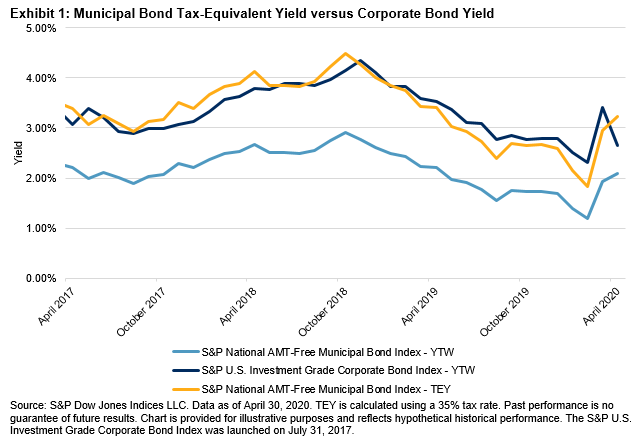Over the past 20 years, the S&P 500® experienced three bear markets with drawdowns greater than 30%—the 2000-2001 Tech Bust, the 2008 Global Financial Crisis (GFC), and the ongoing coronavirus sell-off.
During both the Tech Bust and the GFC, various U.S.-focused dividend indices outperformed the S&P 500. However, during the coronavirus sell-off, most dividend indices underperformed the S&P 500 (Exhibit 1).
The goal of this blog is to examine the characteristics of those dividend indices and factor(s) that contributed to the broad underperformance this time around.

- Not All Dividend Indices Are Created Equal
Each dividend index family has its own unique characteristics and is constructed with the goal of meeting its investment objective.[1] These indices have varying degrees of quality incorporated into their methodology, and can be incorporated into three broad categories: dividend growers, yield/quality blend, and high yielders.

While the indices are expected to have significant exposure to dividend yield, differences in construction among the indices can lead to differing primary and secondary risk exposures. Using a risk model, the fundamental exposures of U.S. dividend indices were examined relative to the S&P 500 over a period of 20 years from Dec. 31, 1999, to April 30, 2020.
The expected trade-off between yield and quality is such that indices selecting higher-yielding constituents tend to have lower relative profitability and higher debt, and a higher risk of falling into the “dividend traps[2].” Indices that focus on dividend growers or blend yield with measures of quality tend to have lower dividend yield, but dividends tend to be more sustainable because of lower debt and higher profitability characteristics.

Exhibit 3 shows that all the dividend indices had lower exposure to volatility than the benchmark. Additionally, upon examining the exposures to the size factor, it is evident the indices had considerable tilt to small-cap stocks; this comes as no surprise, as the indices are either modified market cap-weighted, equal-weighted, or yield-weighted. The last point to note is that all indices were exposed to low growth stocks.
Historically in bear markets, lower volatility and higher quality stocks have tended to outperform the overall market and those stocks with higher volatility and lower quality (Ung & Luk, 2016). Given the factor exposures, it is expected that indices in the dividend growers and yield/quality blend categories would fare better than indices in the higher-yielding category during bear markets. This is largely consistent with what was observed during the Tech Bust and GFC.
In terms of sector exposure, Exhibit 4 shows that all of the dividend indices in the analysis were considerably underweight the Information Technology sector. Sector exposures are more balanced for dividend growers compared to other strategies, which tend to have positive exposure to Utilities and Real Estate. As defensive sectors tend to perform better than cyclical sectors in bear market, similar conclusion can be drawn from the factor exposure based analysis.

- How Is It Different This Time?
While each scenario had different circumstances and causes, the coronavirus sell-off is driven by the simultaneous exogenous shocks of the pandemic and the oil market collapse. The forced shutdown of the global economy and spillover effect of oil price shock led many companies globally to announce a number of changes to their dividend programs in order to preserve cash.
From a factor performance point of view, the coronavirus sell-off resulted in a number of factors behaving unconventionally. For example, low volatility and low beta factors, which are typically defensive, did not have an outsized outperformance, while growth outperformed value (see Exhibit 5). The abnormal behaviors exhibited by these factors led to the relative underperformance of dividend indices between the Feb. 19, 2020, peak and the March 23, 2020, trough.

Moreover, from a sector perspective, the typically defensive Utilities sector underperformed; while Information Technology outperformed. These contributed further to the broad underperformance of dividend indices. Exhibits 6-8 show the return attribution analysis by factor and sector for each of the three bear markets.
Indices that focus on dividend growers or blend yield with quality shielded investors from large losses during the Tech Bust and GFC, but not during the recent Coronavirus sell-off. The reversal in performance could be explained to some extent by the unconventional behavior of some factors (volatility and growth) and sectors (Utilities and Information Technology).



References
Ung, D. a. (2016). What’s in Your Smart Beta Portfolio? A Fundamental and Macroeconomic Analysis. The Journal of Index Investing, 49-77.
[1] https://www.indexologyblog.com/2020/05/12/sp-djis-dividend-indices-the-importance-of-incorporating-quality-screens/
[2] A dividend trap occurs when a high dividend yield attracts investors to a potentially troubled company.
The posts on this blog are opinions, not advice. Please read our Disclaimers.













